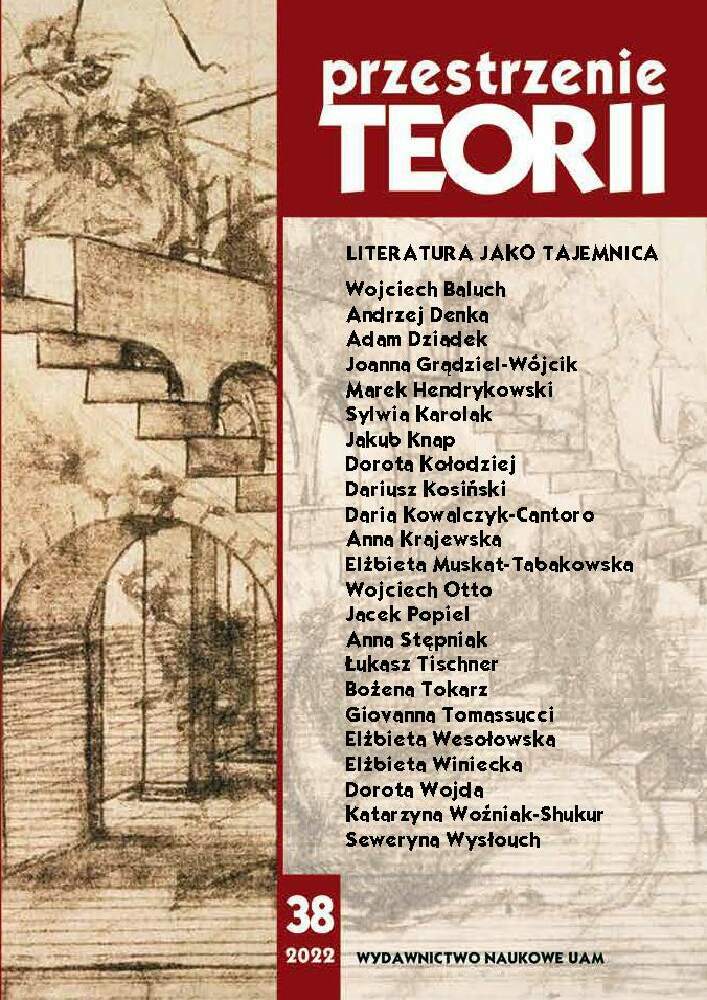Abstract
The aim of this chapter is to present the mythological poem by Claudianus about Proserpine’s kidnapping and marriage. The poem still encourage the scholars to discussion about its aim and the state of its preservation. I will also focus my attention to the intratextual as well intertextual connections joining the poem with itself and the wide ancient tradition. I will propose two very hypothetical lines of interpretation concerning the De raptu Proserpinae.
References
Bielawski K., Dawny żal (palaion penthos) Persefony – twarze Kory w kulcie i micie starożytnej Grecji, [w:] Persefona, czyli dwie strony rzeczywistości, red. M. Cieśla--Korytowska, A. Sokalska, Kraków 2010, s. 9–18.
Bowen E.C., Claudian. The Last of the Classical Roman Poets, „Classical Journal” 1954, 48, s. 355–358.
Claudius Claudian, De raptu Proserpinae, Klaudiusz Klaudian, O porwaniu Prozerpiny, wstęp, przekład i komentarz M. Petry, red. K. Ilski, A. Kotłowska, Poznań 2016.
Cytowska M., Szelest H., Literatura rzymska. Okres cesarstwa, Warszawa 1992.
Danielewicz J., Nowo odczytane teksty Safony i Archilocha, „Meander” 2005, 60, s. 135–146.
Dutsch D., Demeter, [w:] Mit, człowiek, literatura, red. S. Stabryła, Warszawa 1992.
Frisch M., Homo Faber, przeł. I. Krzywicka, Warszawa 1973.
Gruzelier C.E., Temporal and timeless in Claudian’s „De raptu Proserpinae”, „Greece and Rome” 2012, 35, s. 56–78.
Kerenyi K., Eleusis. Archetypowy obraz matki i córki, przeł. I. Kania, Kraków 2004.
Korus K., Żart, śmiech, zabawa w micie o Demeter i Persefonie, [w:] Persefona, czyli dwie strony rzeczywistości, red. M. Cieśla-Korytowska, A. Sokalska, Kraków 2010, s. 19–30.
Musialska I., Mit czterech wieków ludzkości u autorów rzymskich epoki augustowskiej, „Symbolae Philologorum Posnaniensium” 2003, XV, s. 75–90.
Musialska I., Rzymskie poczucie upływu czasu i biegu historii, „Symbolae Philologorum Posnaniensium” 2002, XIV, s. 115–125.
Petry M., Propaganda u Klaudiana, maszynopis pracy doktorskiej, Poznań 2015.
Petry M., Verbal and Situational Parallels in Claudian’s „De raptu Proserpinae”, „Euphrosyne” 2017, s. 287–296.
Stabryła S., Persefona, [w:] Mit, człowiek, kultura, red. idem, Warszawa 1992.
Wesołowska E., Persefona raz jeszcze oraz pewna hipoteza metryczna, „Classica Cracoviensia. Studies of Greek and Roman Literature and Culture” 2011, XIV, s. 369–379.
YMNOI OMEPIKOI, Hymny Homeryckie, przeł. i oprac. W. Appel, Toruń 2001.
Żurek G., Motyw złotego wieku w twórczości Klaudiana, „Meander” 1970, 7–8, s. 290–306.
License

This work is licensed under a Creative Commons Attribution-NonCommercial-NoDerivatives 4.0 International License.
Authors
Authors of texts accepted for publication in Przestrzenie Teorii are required to complete, sign and return to the editor's office the Agreement for granting a royalty-free license to works with a commitment to grant a CC sub-license.
Under the agreement, the authors of texts published in Przestrzenie Teorii grant the Adam Mickiewicz University in Poznań a non-exclusive, royalty-free license and authorize the use of Attribution-NonCommercial-NoDerivatives 4.0 International (CC BY-NC-ND 4.0) Creative Commons sub-license.
The authors retain the right to continue the free disposal of the work.
Users
Interested Internet users are entitled to use works published in Przestrzenie Teorii since 2015, for non-commercial purposes only, under the following conditions:
- attribution - obligation to provide, together with the distributed work, information about the authorship, title, source (link to the original work, DOI) and the license itself.
- no derivatives - the work must be preserved in its original form, without the author's consent it is not possible to distribute the modified work, such as translations, publications, etc.
Copyrights are reserved for all texts published before 2015.
Miscellaneous
Adam Mickiewicz University in Poznań retains the right to magazines as a whole (layout, graphic form, title, cover design, logo etc.).

